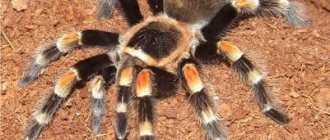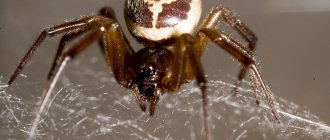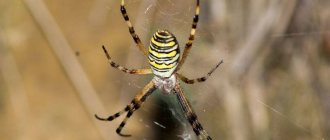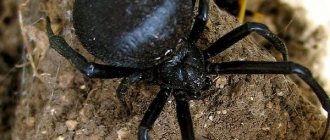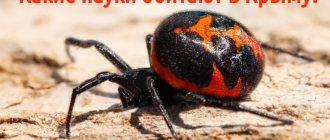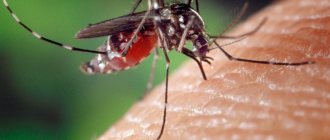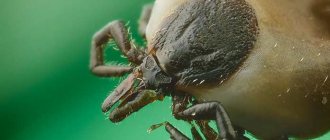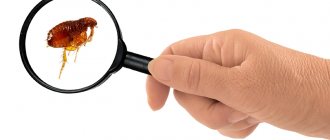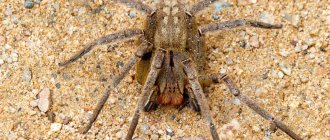The development of mountain tourism in Kazakhstan has led to the fact that people who previously knew nothing about this country began to come there. The websites of travel agencies will tell you about the delights and beauties of the Kazakhstan mountains. But beauties often come with dangers. The worst ones are those that can't be checked or planned for. These unintended dangers include snakes and spiders in Kazakhstan because they are living creatures. They can move and end up in an unexpected place. Including in a tourist tent.
Snakes try to avoid people, most species of spiders do not leave their nests (but no one knows where the next arthropod will decide to settle), but arachnids love to travel. The latter include salpugs and scorpions. All poisonous spiders and arachnids in Kazakhstan have a fairly characteristic appearance. Photos and descriptions are usually enough to recognize the danger during a “personal” meeting.
There are few poisonous spider species in Kazakhstan compared to the variety of dangerous spiders in Australia. But almost all the dangerous spiders of Europe “gathered” in it:
- thirteen-point karakurt;
- Dahl's karakurt;
- white karakurt;
- Heyracantium yellow;
- tarantula.
On a note!
In addition to these species, the country is home to harmless jumping spiders, cross spiders, funnel-web spiders, house spiders and many others. Invertebrates in Kazakhstan are poorly studied and the exact number of spiders is unknown.
Karakurt
It lives in the desert zone, which occupies almost all of Southern Kazakhstan and part of Central Kazakhstan. A medium-sized animal with strong sexual demorphism. The size of the male is about 5 mm and this animal is completely safe for humans.
Karakurt
The female is a serious opponent not only for her prey. The main Kazakh livestock are very sensitive to the venom of this 2 cm arthropod: camels and horses.
Interesting!
Cows and sheep are resistant to karakurt poison.
The Karakurt species Latrodectus tredecimguttatus is a black spider with red or whitish spots on the abdomen. Due to the number of spots, this species is called “thirteen-spotted”. Red spots can be outlined by a white stripe and then look convex. The abdomen is spherical, much larger than the cephalothorax. There is no bristles on the animal, so it looks shiny.
A karakurt bite leads to severe painful spasms throughout the body. All the signs of severe general poisoning are also present. In later stages, excitement gives way to depression. Sometimes the case ends in the death of the victim. To counteract the poison, antikarakurt serum is used.
Karakurt Dalia
Latin name Latrodectus dahli. The difference from the previous type of karakurt is its pure black color without any inclusions. Otherwise, both types of these spiders are identical.
Karakurt Dalia
They build nests at the base of bushes, entwining them with randomly arranged threads. In the desert they prefer to hide in the shadows of animal holes. Sometimes they even coexist peacefully with the real owner of the shelter.
On a note!
Thirteen-spotted and Dahl's karakurt can interbreed with each other, producing intermediate offspring. This makes it difficult for arachnologists to identify a specific individual, but for the average tourist this does not matter. It is enough to remember that spiders with red spots and pure black ones are karakurts.
Poisonous spiders in Kazakhstan (41 photos)
When hearing the word “spider,” many people become hysterical, and for some, the fear of these representatives of the order of arthropods has turned into a real phobia (arachnophobia). Spiders have occupied a certain place in the mythology of various peoples of the world as secretive, dangerous creatures, probably due to their habit of hiding in dark places and suddenly appearing. With the onset of summer this year, cases of people being bitten by spiders have become more frequent. The sudden mass invasion of karakurts is causing concern among experts.
When hearing the word “spider,” many people become hysterical, and for some, the fear of these representatives of the order of arthropods has turned into a real phobia (arachnophobia). Spiders have occupied a certain place in the mythology of various peoples of the world as secretive, dangerous creatures, probably due to their habit of hiding in dark places and suddenly appearing. With the onset of summer this year, cases of people being bitten by spiders have become more frequent. The sudden mass invasion of karakurts is causing concern among experts.
1. This year, employees of the Republican Center of Toxicology have already provided assistance to 30 victims of karakurt bites. All were hospitalized with severe and moderate poisoning. Last year, doctors say, 16 cases of bites were recorded throughout the entire season - from April to October, and at the same time, townspeople mainly went to the hospital after vacationing on Kapchagai or on the Ili River. Now they are bringing victims from the lower regions of Almaty
2. “The most effective treatment in this case is anti-karakurt serum, which is prepared at the Tashkent Bacteriological Institute, but we do not have a license to purchase it,” says the head of the department, a doctor of the highest category, the chief freelance toxicologist of Almaty, Gulmira Muratovna Toybaeva. — Intravenous administration of novocaine, calcium chloride and magnesium hydrogen sulfate also gives good results - this is what we use. The main thing is to make the correct diagnosis in time
3. This man was bitten by a karakurt in the Almaty-1 area. “I was sitting on the porch at home, felt a slight prick in my leg, as if bitten by a mosquito, but did not attach any importance to it. After some time, there was a sharp pain in the groin and abdomen, and a headache. I began to feel nauseous and began to sweat profusely. They took me to the hospital, and here I was admitted to the hospital for five days with a diagnosis of a karakurt spider bite. The venom of the karakurt is 15 times stronger than the venom of a rattlesnake. The spider bite does not hurt, but a small red spot appears at the site of the bite, which quickly disappears. The bitten area does not swell, the pain goes away quickly, and in a dream the bite may not be noticed
4. “But while we are afraid of spiders, they very rarely bite people, only a few of them are able to bite through human skin,” reassures arachnologist, researcher at the entomology laboratory of the Institute of Zoology of the National Academy of Sciences of the Republic of Kazakhstan, Alexander Gromov. — The majority of spider species are not aggressive at all and do not pose any threat. In addition, spiders bite only in defense. As Alexander suggests, this year is not a peak year, that is, in the next few years there will be another outbreak of cases of karakurt bites in Kazakhstan
5. “Yes, this year there are a lot of karakurts again, but there is nothing supernatural here, this happens once every 10-15 years, this is nature,” says the arachnologist. “Just recently, an acquaintance brought me a spider; it turned out to be a female karakurt. But the most interesting thing is that she was caught in the area of Timiryazev - Baizakov streets, almost in the city center. Of course, this does not mean that they have already occupied the entire city, maybe the spider was simply brought on the bottom of a car from the same Kapchagai, there is no need to cause a panic. But you still have to be more careful
6. In order to somehow understand the current situation and find out the expert’s opinion, I asked the scientist to give me a tour of the Almaty region and tell me about some representatives of the arachnid class. We were mainly interested in species dangerous to humans
7. Web of the Agelen spider. Under the common name "spider" there are approximately 34,000 species of arthropods. Spiders belong to the class of arachnids or arachnids, other orders of this class include scorpions, phalanges, harvestmen, false scorpions, etc.
8. In general, spiders are carnivores and feed only on live prey. They capture prey with their pedipalps (legs) and inject venom through their chelicerae (oral appendages)
9. Tarantula is a large spider of the wolf spider family. Several species of tarantulas live in Kazakhstan. Lives in earthen burrows along the banks of rivers, lakes, salt marshes, etc. A tarantula bite is painful but not fatal, comparable to a bee sting. We met him near the Ili River. Size about 7 cm
10. Tarantula lives in holes up to 30-40 cm deep, lined with cobwebs; when an insect appears near the hole, it quickly jumps out and catches it. The spider is sensitive to what is happening on the surface, including the movement of passing insects, which also serves as a reason for an attack
11. Alexander collects various representatives of arachnids for further study. The place of capture is recorded on GPS, a detailed label is written with information about the place of collection with the date and name of the collector, and this information is subsequently entered into a computer database. This database is used, for example, to map the ranges of arachnids
12. On the bank of the Kurta River. The place where karakurt was recorded most often. — Some spider experts claim that the fact that spiders have settled in Almaty is the fault of shish kebab makers, importers of saxaul or suppliers of melons. But this information has not yet been confirmed
13. Spiders, scorpions, phalanges usually hide from our eyes and certainly do not intend to attack humans
14. Karakurt’s favorite habitats are virgin wormwood, wastelands, banks, and ravine slopes. This spider likes to settle in stone rubble, in rodent burrows, at the base of walls, in cracks, in places where firewood is stored, in dry piles of old garbage.
15. The common neighbor of the karakurt is the harmless Agelen spider, with characteristic stripes on its back. Their networks are often woven side by side and even touch. To an experienced observer, the presence of an agelena indicates that a karakurt also lives somewhere nearby. Of course, this is only true for the area where it is found.
16. In Kazakhstan, karakurt lives in steppes, semi-deserts and deserts of all regions except North Kazakhstan. In the Almaty region, you can meet a dangerous spider in the desert and steppe, along the intercity routes Almaty - Bishkek, Almaty - Taldykorgan, Almaty - Astana, on the Ili River, Kapchagai Reservoir
17. Last year’s nest of karakurt in the vicinity of the village of Bakbakty
18. “So that the poison does not spread so quickly through the blood, a person needs peace,” says Alexander Gromov, who experienced the effect of spider jaws. - You need to lie down in a cool place, drink as much water as possible - it dilutes the poison and removes it from the body naturally faster. But taking alcohol as a medicine, as many vacationers do, is dangerous. In the first minutes after the bite, you need to cauterize the area. This is done like this: one unlit match should be applied with the head to the bite site. Set the second one on fire and bring it to the head of the first one. A flash will occur on the surface of the skin. It hurts, but it's not fatal. The fact is that karakurt bites through human skin no more than a millimeter. When cauterized with a match, the poison is quickly destroyed, and the symptoms of poisoning gradually disappear. But you still need to see a doctor
19. Once upon a time, hundreds of spiders hatched from them
20. One of the favorite habitats of karakurt is the base of rocks
21. Female karakurt. The body of the spider is completely black, with red spots with a white border on the abdomen (only in immature ones and in males), the legs are thin and smooth. The spider has an average size: the female is 10-20 mm, the male is 4-7 mm.
22. Immature female. Females are the most poisonous, while males do not pose a particular danger to humans and animals, since they are unable to bite through the skin. Spiders bite most often during the migration period, in July-August
23. Using a special spade knife, a scientist digs up a mink
24. Menacing pose of the South Russian tarantula. Among our tarantulas, one of the largest - up to 15 cm including legs. The spider is poisonous, rarely bites humans, causes local swelling and severe pain. There is no reliable information about fatal cases, but in children the consequences of bites are very severe and may not heal for 2-3 days
25. The main types of arachnids come to the surface at night. At night, spiders become more active, leaving their shelter a short distance and hunting insects. During a night survey of the Balkhash deserts using an ultraviolet lamp, Alexander easily finds scorpions and phalanges
26. They simply glow in ultraviolet light
27. In the Almaty region, three types of scorpions are most common: yellow, Caucasian, Rickmers scorpion is less common
28. “Scorpion stings cause burning pain and are especially dangerous for allergy sufferers,” says the specialist. — If a scorpion bites you in the neck or heart area, the consequences can be sad
29. Yellow scorpion (female) - the most common species in the Almaty region
30. Caucasian scorpion (male)
31. The largest species of scorpions in Kazakhstan: up to 8 cm.
32. A female tarantula Evippus with her cubs on a night walk. Several dozen spiders fit on its abdomen. Common prey for an adult tarantula: locusts, grasshoppers, crickets and various beetles
33. Just like the scorpions, the phalanx also came under the sight of an ultraviolet lamp. The reason spiders glow is a thin layer of organic substance hyaline, the chemical composition of which has not yet been identified.
34. Tomorrow afternoon we will look at it in daylight
35. Caspian phalanx (pregnant female). Phalanx or salpuga also belong to the order of arachnids. Inhabits arid areas. The Caspian phalanx, for example, reaches a length of 5-7 centimeters. Its body and limbs are covered with long hairs. The pedipalp tentacles located in front are very similar to limbs and perform their function
36. All phalanges are very mobile and almost all of them are nocturnal predators. Phalanges are carnivorous or omnivorous, feeding on termites, darkling beetles, and other small arthropods, but can also eat larger animals such as lizards. When attacked, the phalanges emit a hissing or chirping sound by rubbing the chelicerae against each other
37. Day phalanx (female). Small phalanges cannot bite through human skin, but large ones are able to do this. Phalangeal bites are very painful. They often go away without any consequences.
38. Agelena spider nest
39. Female Agelen spider. Due to ignorance, it is often confused with a tarantula. Its bite is completely painless
40. In order to avoid being bitten by spiders, the best thing is not to meet them at all. You should not walk through thickets of bushes, hollows and ravines, where there may be spider nests, or leave clothes or other objects on bare ground - arthropods can easily crawl into them
41. Of course, a spider looks scary, and many types of spiders are poisonous and can cause serious harm to health. But they are still very useful animals that destroy harmful insects. We encounter them all the time, as they are one of the largest groups on the planet. People, in general, have a bad habit of disturbing the life of the natural world and often undeservedly kill these creatures
White karakurt
The only “blonde” among poisonous spiders in Kazakhstan, although its range extends throughout Central Asia and the Middle East, covering Russia and North Africa. This is a species more adapted to cold weather than black karakurts. It chooses habitats in the steppe and desert zones, so it can be found not only next to its black counterparts, but also in Western Kazakhstan.
White karakurt
The habits are similar to other spiders of the black widow genus. The appearance differs from Dahl's karakurt only in color. The white karakurt got this name for a reason. His belly is completely white. The cephalothorax is also devoid of pigment and, due to the characteristics of the chitinous integument, has a light brown color. Due to the lack of pigment, the cephalothorax appears translucent.
On a note!
Since this is the least poisonous species, it is not dangerous for an adult. But the effect of the poison is similar to the effect of black karakurt toxins. With a weakened body, even white poison can lead to death. Such cases have been recorded in the elderly and children.
Heiracanthium yellow
The second name of the spider is yellow sak. Cheiracanthium received the adjective “yellow” because of its dirty yellow color. Thanks to this color, it is invisible against the background of withered grass in the steppe. This spider prefers arid regions and is distributed from Central Asia to Central Europe. Today it has begun to penetrate into more northern and colder areas. The range is expanding due to climate change, as the spider prefers relatively hot regions. In Kazakhstan it can be found everywhere except Eastern Kazakhstan, where winters are very harsh.
Heiracanthium yellow
On a note!
Heiracanthium weaves a web on steppe grasses. The spider's body length is 1.5 cm. Its prey is agricultural pests with hard chitinous shells. Because of this, spider chelicerae are adapted to pierce hard covers, and human skin is not an obstacle for them.
In terms of the effectiveness of the venom and the pain from the bite, this yellow spider is equal to the wasp. A spider bite does not cause serious consequences, although pain and swelling persist for several hours.
Appearance and features
Photo: What a phalanx spider looks like
The body of the hodgepodge is divided into two parts:
- prosoma (shell);
- opisthosoma (abdominal cavity).
The prosoma consists of three sections:
- propeltidium (head) contains chelicerae, eyes, pedipalps and the first two pairs of legs;
- mesopeltidium contains a third pair of legs;
- metapelptidium contains a fourth pair of legs.
Outwardly, the phalanx spider appears to have 10 legs, but in fact, the first pair of appendages are very highly developed pedipalps, which are used for various functions such as drinking, catching, feeding, mating and climbing. Only the three rear pairs of legs are primarily used for running. The most unusual feature is the unique organs at the tips of the legs. Some spiders can use these organs to climb vertical surfaces.
The first pair of legs is thin and short and is used as tactile organs (tentacles). The phalanges lack a patella (a leg segment found in spiders, scorpions and other arachnids). The fourth pair of legs is the longest. Most species have 5 pairs of ankles, while juveniles have only 2-3 pairs. They were assumed to be sensory organs for detecting vibrations in the soil.
Body length varies from 10-70 mm, and leg span up to 160 mm. The head is large and supports large, strong chelicerae (jaws). The propeltidium (carapace) is raised to accommodate the enlarged muscles that control the chelicerae. Because of this elevated structure, they are often called "camel spiders" in the English-speaking segment. The chelicerae have a fixed dorsal digit and a movable ventral digit, both armed with cheliceral teeth for crushing prey. These teeth are one of the features used in identification.
Some species have very large central eyes. They can recognize shapes and are used to hunt and spy on enemies. These eyes are remarkable for their internal anatomy. Many species lack lateral eyes, and where they exist at all, they are only rudimentary. The abdomen is soft and expandable, allowing the animal to eat large quantities of food. The body of many species is covered with bristles of varying lengths, some up to 50 mm, resembling a shiny hairball. Many of these bristles are tactile sensors.
Tarantula
The main poisonous spiders in Eastern Kazakhstan are tarantulas. Wolf spiders, which include tarantulas, like their mammalian namesakes, have adapted to life in any conditions. Even the winters of Eastern Kazakhstan with their -50°C do not frighten tarantulas. Spiders that are more dangerous to humans prefer warm places.
Tarantula
The most numerous species not only in the eastern part, but throughout the country is the South Russian tarantula. Due to the very favorable living conditions in the summer in Kazakhstan, this species grows 2 times larger than usual and reaches 5 cm. The color of these spiders can be greenish-gray, gray or yellow-gray.
On a note!
Tarantulas are true earth spiders that build their own burrows. They dig deep vertical “wells” in which they wait for prey. The probability of accidentally disturbing a tarantula, unlike a karakurt, is very small. But tarantulas hunt at night and can crawl into a tent in search of prey.
They do not like to settle only in the forest. They are found in forest-steppe, steppe, semi-desert and desert areas. That is, throughout the entire territory of Kazakhstan.
Phalanx spider (salpuga) - description, structure, characteristics, photo
The phalanx spider can reach a length of 7 cm. The cephalothorax has a dissected structure. On its anterior section, covered with a durable chitinous shield, there are two bulging eyes, large chelicerae (oral appendages) with powerful pincers, short pedipalps with sensitive appendages, and walking legs. In total, the salpuga (phalanx) has 10 legs.
Unlike the front legs, which perform a tactile function, the hind legs of the salpuga are equipped with tenacious claws, between which there are peculiar suction cups. Thanks to this arrangement of limbs, camel spiders easily climb vertical surfaces.
The large abdomen of the phalanx is spindle-shaped and consists of 10 complex segments, each of which is formed by a hard abdominal and dorsal part and is connected to the cephalothorax like a waist.
Salpugs have well-developed tracheal breathing, consisting of powerful longitudinal trunks and a system of small branching air vessels with spiral thickenings of the walls, which permeate the entire body of the camel spider.
The entire body and appendages of these arachnids are covered with a huge number of thin hairs and bristles of varying thickness and length. This unusual “hair” of the salpug, combined with its large size and rapid movements of the phalanges, gives them a rather menacing appearance, allowing them to scare off a potential enemy.
In addition, with the help of chelicerae, salpugs can make grinding or squeaking sounds designed to intimidate the enemy.
One of the characteristics of a phalanx spider is powerful chelicerae. In the structure of each chelicera, there are 2 parts that are held together by a joint. As a result, the chelicera looks like a crab claw, as can be seen in the photo below. The chelicerae of the phalanx contain teeth, the number of which depends on the type of arachnid.
The salpuga's chelicerae are so powerful that they allow it to cut off the fur and feathers of its prey, cut the skin and cut the bones of birds. When in danger, the phalanges squeak or chirp piercingly due to the friction of the chelicerae against each other.
The color of the phalanx spider is determined by its habitat, and salpugs live in desert and arid areas, so most species have a characteristic color in whitish, yellowish and brown tones. As an exception, variegated individuals are observed.
Central Asian salpuga
Karakurt is not the only danger in Kazakhstan. In addition to spiders, there are salpugs (phalanxes). These are arachnids belonging to the order phalanges. Nowadays, representatives of the order are usually called salpugas, so as not to be confused with the order Phalangida, consonant with the phalanges - arachnids better known as haymakers (kosinozhki).
Central Asian salpuga
Interesting!
Although from a biological point of view, salpuga does not belong to real spiders, the name phalanx - spider - has been used in Kazakhstan since ancient times. Often in Central Asia it is called the camel spider.
The Central Asian salpuga grows up to 7 cm. The color is camouflage: gray-yellow. This is a nocturnal hunter who is able to crawl into a home at night. Salpuga differs from spiders not only in the absence of arachnoid and poisonous glands. She has 2 pairs of mandibles with teeth instead of one pair of chelicerae and 5 pairs of walking legs versus the spider’s 8 legs.
Small salpugs are not dangerous to humans, as they are not able to bite through the skin. Large ones can infect sepsis when bitten, since decaying pieces of flesh from the previous victim remain on the mandibles.
Social structure and reproduction
Photo: Camel spider in Russia
With the onset of the mating season, the female begins to emit a specific smell, which the male smells with the help of his pedipalps. Mating occurs at night, after which the male must quickly retreat as the female begins to show signs of aggression.
Fertilized female phalanges are particularly gluttonous. During copulation, they are so passive that the male has to drag them along with him. But at the end of the process, the females become so excited that the male has to run away so as not to become a snack.
The male releases a sticky spermatophore onto the ground, collects it with chelicerae and inserts it into the female’s genital opening. The process takes several minutes. The movements of the male during mating are reflexive. Once the process has begun, the male will not complete it, even if the female or spermatophore is removed from him.
The fertilized female begins to feed intensively, after which she digs a hole and lays 30-200 eggs of different types in it. The development of embryos begins in the female’s oviducts, so after 2-3 weeks small spiders are born.
At first, the young are practically motionless, without hairs, covered with a thin cuticle. After a couple of weeks, molting begins, the integument hardens, the babies grow hairs and make their first movements. At first, the female takes care of the offspring, looking for food until the cubs get stronger.
